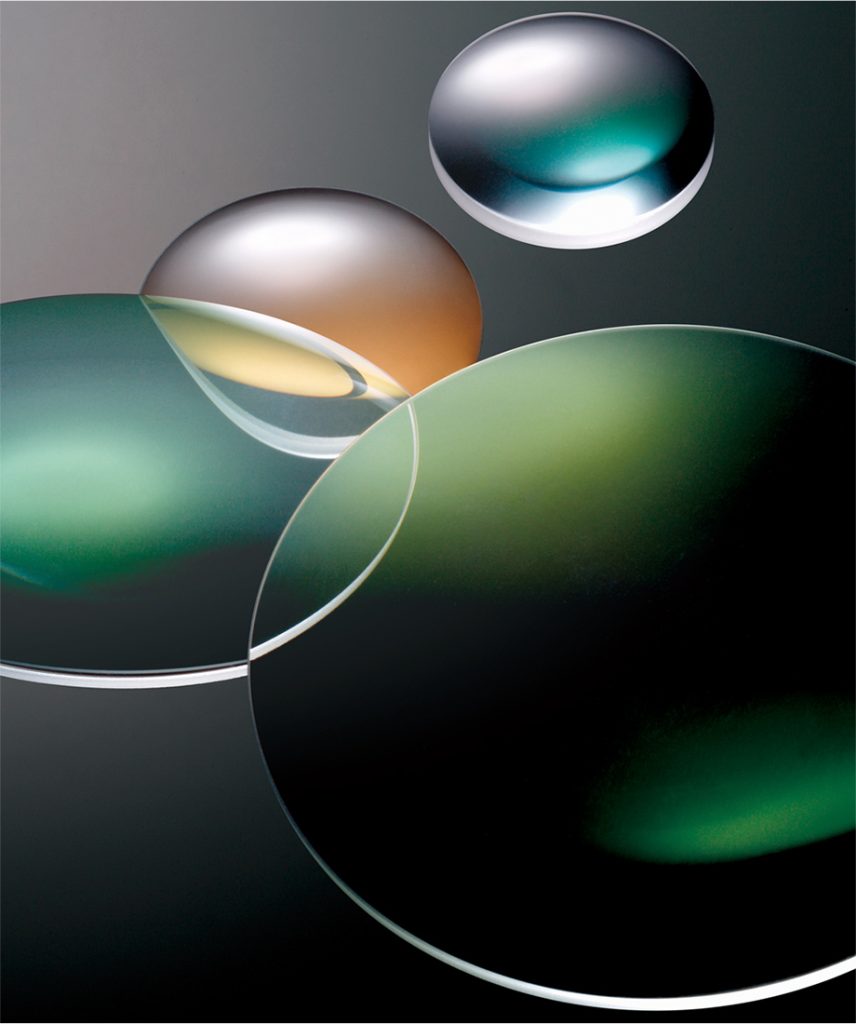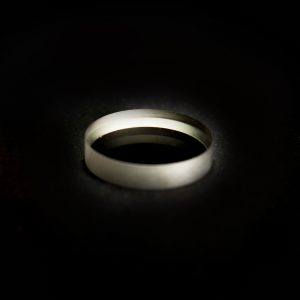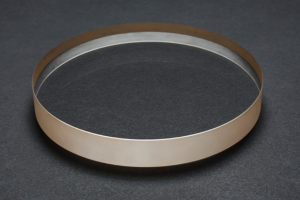
Glass that can change the propagation direction of light and the relative spectral distribution of ultraviolet, visible or infrared light. In a narrow sense, optical glass refers to colorless optical glass; In a broad sense, optical glass also includes colored optical glass, laser glass, quartz optical glass, anti radiation glass, ultraviolet infrared optical glass, fiber optical glass, acoustooptic glass, magneto-optical glass and photochromic glass. Optical glass can be used to manufacture lenses, prisms, mirrors and windows in optical instruments. The components composed of optical glass are the key components in optical instruments.
Optical glass concept
An amorphous (glassy) optical dielectric material that transmits light. It can be used to make prisms, lenses, filters and other optical elements. After the light passes through, it can change the propagation direction, phase and intensity. According to different requirements, optical glass can be divided into three categories: ① colorless optical glass – almost completely transparent in a wide range of visible and near-infrared bands, which is the most used optical glass. According to the difference of refractive index and dispersion, there are hundreds of brands, which can be divided into two varieties, namely coronal optical glass (represented by K) and flint optical glass (represented by F). Crown glass is borosilicate glass, which becomes flint glass after adding alumina. The main difference between the two is that flint glass has large refractive index and dispersion, so it is often used to make spectral elements. ② Radiation resistant optical glass – it has various properties of colorless optical glass and can basically not change its properties under radioactive irradiation. Used by γ The variety and brand of irradiated optical instruments are the same as that of colorless optical glass. Its chemical composition is to add a small amount of cerium dioxide on the basis of colorless optical glass to eliminate the color center formed by high-energy radiation in the glass, so that the light absorption of this glass changes little after irradiation. ③ Colored optical glass – having specific absorption or transmission properties for certain wavelengths of light. Also known as filter glass, there are more than 100 varieties. The color filter can selectively absorb some colors, and the neutral filter absorbs the same light of all wavelengths, but reduces the beam intensity without changing its color. The interference filter is based on the interference principle of light and reflects the unwanted color instead of absorbing it.
In recent years, some new varieties of optical glass have been developed, such as glass with good transmittance to infrared and ultraviolet; Glass with extremely high or low refractive index or dispersion; Glass that changes color with light intensity; A magneto-optical glass in which the polarization plane rotates when light passes through the glass along the direction of the magnetic line of force; Electro optic glass that produces birefringence under the action of external electric field, etc.
Prospect of optical glass
Optical glass is the foundation and important part of photoelectric technology industry. Especially after the 1990s, with the continuous integration of optics, electronic information science and new material science, the application of optical glass as optoelectronic basic material in the three fields of optical transmission, optical storage and optoelectronic display has made rapid progress, and has become one of the basic conditions for the development of social informatization, especially optoelectronic information technology.
With the sustained and stable development of domestic economy, China’s optical glass manufacturing industry has developed rapidly. According to the data of the National Bureau of statistics, in 2010, the number of Enterprises above Designated Size in the optical glass manufacturing industry reached 246, and the annual sales revenue of the industry was 23.405 billion yuan, a year-on-year increase of 53.70%; The profit was 1.537 billion yuan, a year-on-year increase of 87.10%; The scale of assets reached 26.45 billion yuan, a year-on-year increase of 77.49%. As the optical glass manufacturing industry is dominated by domestic sales, the impact of the financial crisis is relatively small, and the industry still shows a good growth momentum.

Optical glass product introduction
Glass materials used for manufacturing lenses, prisms, mirrors, windows, etc. of optical instruments or mechanical systems. Including colorless optical glass (usually referred to as optical glass), colored optical glass, radiation resistant optical glass, anti radiation glass and optical quartz glass. Optical glass has high transparency, high uniformity in chemistry and Physics (structure and properties), and specific and accurate optical constants. It can be divided into silicate, borate, phosphate, fluoride and sulfur compounds. There are many varieties, which are mainly classified according to their position in the refractive index (nd) – Abbe value (VD) diagram. Traditionally, all kinds of glasses with Nd > 1.60, VD > 50 and nd < 1.60, VD > 55 are defined as coronal (k) glass, and the rest are defined as flint (f) glass. Coronal glass is generally used as convex lens and flint glass as concave lens. Generally, crown glass belongs to alkali containing borosilicate system, light crown glass belongs to aluminosilicate system, heavy crown glass and barium flint glass belong to alkali free borosilicate system, and most flint glass belongs to lead potassium silicate system. With the continuous expansion of the application field of optical glass, its varieties are expanding, and its composition includes almost all the elements in the periodic table.
An inorganic glassy material that transmits light by refraction, reflection and transmission or changes the intensity or spectral distribution of light by absorption. It has stable optical properties and high optical uniformity.
Optical glass optical classification
Colorless Optical Glass
It has specific requirements for optical constants and has the characteristics of high transmittance in the visible region and no selective absorption coloring. According to the Abbe number, it is divided into coronal glass and flint glass, and all kinds are divided into several kinds according to the refractive index, which are arranged in turn according to the refractive index. It is mainly used as lens, prism and mirror of telescope, microscope and camera.
Anti irradiation optical glass
It has great absorption capacity for high-energy irradiation. There are high lead glass and cao-b2o2 system glass. The former can prevent γ X-ray and X-ray irradiation. The latter can absorb slow neutrons and thermal neutrons. It is mainly used in nuclear industry and medical fields as shielding and peeping window materials.
Irradiation resistant optical glass
In a certain γ Under X-ray and X-ray irradiation, the transmittance in the visible region changes less, and the variety and brand are the same as that of colorless optical glass. It is used to manufacture optical instruments and peep windows under high-energy irradiation.
Colored optical glass
Also known as filter glass. It has selective absorption and transmission properties for specific wavelengths in ultraviolet, visible and infrared regions. According to spectral characteristics, it is divided into three categories: selective absorption type, cut-off type and neutral gray; According to the coloring mechanism, it can be divided into three categories: ion coloring, metal colloid coloring and sulfur selenide coloring, which are mainly used in the manufacture of optical filters.
Ultraviolet and infrared optical glass
It has specific optical constant and high transmittance in ultraviolet or infrared band. It is used as ultraviolet and infrared optical instruments or window materials.
Optical quartz glass
With silica as the main component, it has the characteristics of high temperature resistance, low expansion coefficient, high mechanical strength and good chemical properties. It is used to manufacture prisms, lenses, windows and mirrors with special requirements for transmission in various bands. In addition, there are photomask plates, liquid crystal display panels, image optical disc base sheet glass for large-scale integrated circuit manufacturing; A magneto-optical glass in which the polarization plane rotates when light passes through the glass along the direction of the magnetic line of force; When light passes through the glass transmitting ultrasonic wave in a certain direction, it will diffract, reflect, converge or shift the optical frequency
Dispersion classification
According to dispersion, it can be divided into two categories: coronal (k) with less dispersion and Flint (f) with greater dispersion.
① Coronal optical glass is divided into fluorine coronal (FK), light coronal (QK), phosphorus coronal (PK), heavy phosphorus coronal (ZPK), coronal (k), heavy coronal (zk), barium coronal (bak), lanthanum coronal (LAK), titanium coronal (Tik) and special coronal (TK).
② Flint optical glass is divided into light flint (QF), Flint (f), heavy flint (ZF), barium flint (BAF), heavy barium flint (ZBAF), lanthanum flint (LAF), heavy lanthanum flint (zlaf), titanium Flint (TIF), coronal Flint (KF) and special Flint (TF). They are distributed in different fields in the relationship image between refractive index nd and dispersion coefficient v.
Radiation resistant glass
Radiation resistant glass is a kind of glass in a broad sense. Including radiation proof glass and radiation resistant glass. Radiation proof glass is mainly used for γ Glass with large absorption capacity of X-ray and X-ray. When γ When X-rays or X-rays enter the protective glass, due to the photoelectric effect generated inside the glass, positive and negative electron pairs are generated, and excited and free electrons are generated at the same time γ The energy of X-ray or X-ray decreases and the penetration decreases, which plays a protective role.
When the density of radiation proof glass increases, the shielding capacity increases accordingly. Guard against γ The density of ray glass is usually not less than 4.5g/cm. In recent years, glass with a density of 6.2 ~ 6.5g/cm has been used, and ZF series is commonly used.
Radiation resistant optical glass mainly refers to γ Optical glass that is not easily colored under the action of rays. The designation of radiation resistant optical glass brand still indicates the number of roentgen that can withstand radiation according to the optical glass brand. For example, k509 radiation resistant optical glass has the same optical constant as K9 and can withstand 10 roentgen dose γ Ray. Ordinary glass is radiated by high-energy rays to produce free electrons, which combine with the vacancy inside the glass to form a color center. At the same time, it can also shift the atomic nucleus, destroy the normal structure, produce color centers and color the glass.
CeO2 is introduced into radiation resistant optical glass γ After X-ray irradiation, due to formula ①, electrons can be captured without color centers in the glass, and the absorption bands of CE and CE are in the ultraviolet region. When the CeO2 content is too high, the ultraviolet and infrared absorption bands extend to the visible region, increasing the absorption of the blue region of the visible light, resulting in the yellow of the glass. At the same time, the color will be deepened due to the influence of other components in the glass, so the content of CeO2 cannot be too high. The content of CeO2 in k509 is about 0.4% ~ 0.5%, and that in k709 is about 1%.
Raw materials for optical glass production
With high-quality quartz sand as the main material. Add auxiliary materials appropriately. Because rare earth has high refractive index, low dispersion and good chemical stability, it can produce optical glass for making lenses of advanced optical instruments such as advanced cameras, cameras and telescopes. For example, a kind of lanthanum glass with excellent optical properties containing 60% of lanthanum oxide and 40% of boron oxide is an indispensable optical material for manufacturing the lens of advanced camera and periscope. In addition, radiation proof glass can be produced by using the radiation proof characteristics of some rare earth elements.
Production method of optical glass
The raw materials for the production of optical glass are some oxides, hydroxides, nitrates and carbonates, and phosphate or fluoride are introduced according to the requirements of the formula. In order to ensure the transparency of glass, the content of coloring impurities must be strictly controlled, such as iron, chromium, copper, manganese, cobalt, nickel, etc. Accurate weighing and uniform mixing are required during batching. The main production processes are melting, forming, annealing and inspection.
optical glass
① Smelting includes single crucible intermittent smelting method and tank kiln (see kiln) continuous smelting method. Single crucible smelting method can be divided into clay crucible smelting method and platinum crucible smelting method. No matter what smelting method is adopted, it needs to be stirred by agitator, and the temperature and stirring shall be strictly controlled to make the glass liquid highly uniform. Clay crucible can melt most coronal glass and flint glass with low cost, and can be used when the melting temperature of glass exceeds the service temperature of platinum. Platinum crucible can melt glass with high quality and serious erosion to clay crucible, such as heavy crown, heavy barium flint, rare earth glass and fluorine phosphorus glass. Platinum crucible is heated by electricity. Generally, silicon carbide rod or silicon molybdenum rod electric furnace is used. However, high frequency heating can be used to manufacture glass with large crystallization tendency, rapid cooling and certain requirements for atmosphere.
Since the 1960s, countries have successively adopted continuous tank furnace smelting lined with platinum, which has greatly improved the output and quality of optical glass. This is the main trend of the development of optical glass production technology at present.
② The forming methods of forming optical glass include classical crucible breaking method, rolling method and pouring method, but at present, leakage forming (using single crucible or continuous melting to flow out the material liquid) is more and more widely used, which can directly pull the rod, drop the material, press the mold or leak the material to form large-size blanks, so as to improve the utilization rate of material drops and the rate of finished products.
③ Annealing in order to eliminate the internal stress of glass to the greatest extent and improve the optical uniformity, we must formulate a strict annealing system and carry out precision annealing.
④ The inspection and measurement indexes include: optical constant, optical uniformity, stress birefringence, fringe, bubble, etc.
Quality requirements for optical glass
The difference between optical glass and other glasses is that as an integral part of optical system, it must meet the requirements of optical imaging. Therefore, the judgment of optical glass quality also includes some special and strict indexes. There are the following requirements for optical glass: first, the specific optical constants and the consistency of the optical constants of the same batch of glass
Each kind of optical glass has a specified standard refractive index value for light of different wavelengths, which can be used as the basis for optical designers to design optical systems. Therefore, the optical constants of the optical glass produced by the factory must be within a certain allowable deviation range of these values, otherwise the actual imaging quality will be inconsistent with the expected results in the design, which will affect the quality of the optical instrument. At the same time, because the same batch of instruments are often made of the same batch of optical glass, in order to facilitate the unified correction of the instruments, the allowable deviation of the refractive index of the same batch of glasses is more strict than their deviation from the standard value.
2、 High transparency
The brightness of optical system imaging is proportional to the transparency of glass. The transparency of optical glass to light of a certain wavelength is measured by light absorption coefficient K λ express. After light passes through a series of prisms and lenses, part of its energy is lost in the interface reflection of optical parts, while the other part is absorbed by the medium (glass) itself. The former increases with the increase of glass refractive index. For high refractive index glass, this value is very large. For example, for heavy flint glass, the light reflection loss on one surface is about 6%. Therefore, for the optical system with multiple thin lenses, the main way to improve the transmittance is to reduce the reflection loss on the lens surface, such as coating the surface antireflection film. For large-scale optical parts, such as the objective lens of astronomical telescope, due to its large thickness, the transmittance of the optical system mainly depends on the light absorption coefficient of the glass itself. By improving the purity of glass raw materials and preventing any colored impurities from mixing in the whole process from batching to smelting, the light absorption coefficient of glass can generally be less than 0.01 (that is, the light transmittance of glass with a thickness of 1 cm is greater than 99%).
Optical cold working
The utility model relates to a super hard fireproof glass, a manufacturing method and special equipment thereof, which uses chemical vapor phase heat treatment means and a single piece of sodium calcium silicon glass to change its original molecular structure without affecting the original color and light transmittance of the glass, so as to make it reach the super hardness standard and meet the fire protection requirements under the impact of high-temperature flame. It is made of the following components by weight: potassium salt vapor (72% ~ 83%), argon (7% ~ 10%), gaseous copper chloride (8% ~ 12%), nitrogen (2% ~ 6%). It includes the following process flow: cold processing of cutting and fine grinding with soda lime silica glass as substrate → chemical vapor heat treatment of soda lime silica glass after cold processing → treatment of plating fireproof protective film on soda lime silica glass surface → special physical tempering treatment on soda lime silica glass surface. A special thermal decomposition gasification equipment is composed of a cylinder block, a cylinder head sleeved with it and a reaction kettle integrally connected with the cylinder head.
Development of optical glass
The development of optical glass and optical instruments are inseparable. The new reform of optical system often puts forward new requirements for optical glass, which promotes the development of optical glass. Similarly, the successful trial production of new varieties of glass often promotes the development of optical instruments in turn.
The earliest optical material used to make optical parts was natural crystal. It is said that ancient Asia used crystal as lens, while in ancient China, natural tourmaline (tea mirror) and Topaz were used. Archaeologists proved that people could make glass in Egypt and us (Warring States period) 3000 years ago. But glass as glasses and mirrors began in Venice in the 13th century. Engels gave this in “natural dialectics”.
End



